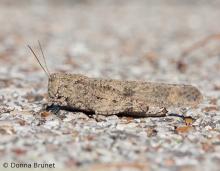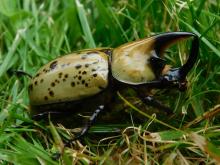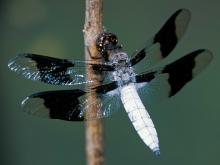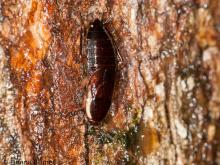Land Invertebrates
Media

Species Types
Scientific Name
Dissosteira carolina
Description
The Carolina grasshopper is frequently seen in dusty, open habitats like dirt roads and vacant lots. Its yellow-bordered, black hindwings make it look like a mourning cloak butterfly.
Media

Species Types
Scientific Name
Dynastes tityus
Description
The eastern Hercules beetle is a breathtaking animal. Like its Greek-hero namesake, it is big and strong. Males have horns; females do not. Hercules beetles are harmless to people.
Media

Species Types
Scientific Name
Dromogomphus spp.
Description
Spinyleg clubtails are dragonflies in genus Dromogomphus. There are at least three species that look very similar.
Media

Species Types
Scientific Name
Gomphurus vastus
Description
The cobra clubtail is in the family of dragonflies called clubtails, named for the enlarged abdomen tip. There are about 100 species in this dragonfly family in North America north of Mexico.
Media

Species Types
Scientific Name
Tramea lacerata
Description
The black saddlebags is a dragonfly with memorable markings. Two dark blotches on each hindwing look like saddlebags.
Media

Species Types
Scientific Name
Libellula pulchella
Description
The twelve-spotted skimmer has twelve brown wing spots. Males, like this one, have eight additional spots that are white. Females lack the white spots.
Media

Species Types
Scientific Name
Phanogomphus graslinellus
Description
The pronghorn clubtail is one of several members of its genus in our area that are generally difficult to identify. Like other dragonflies, it is an aerial predator that hunts insects on the wing.
Media

Species Types
Scientific Name
Plathemis lydia
Description
The common whitetail is a widespread species found across much of North America. Males and females look quite a bit different.
Media

Species Types
Scientific Name
Schistocerca spp.
Description
About six species of bird grasshoppers occur in Missouri. Most are attractively marked, large insects that gracefully fly from danger, almost like birds.
Media

Species Types
Scientific Name
Over 100 species of cockroaches and termites in North America north of Mexico
Description
Cockroaches well-known: they are flattened, small, brown or black, often shiny insects that can hide in tight crevices and lack specialized appendages. Recently, termites have been included in their order.
See Also



Media

Species Types
Scientific Name
Cisseps fulvicollis
Description
The yellow-collared scape moth is more often “orange-collared.” And whether you think it looks more like a firefly or a wasp, it’s still a moth!
Media

Species Types
Scientific Name
Nearly 150 species in North America north of Mexico
Description
Slim, delicate plume moths are instantly recognizable by their T-shaped silhouette, long legs, and muted shades of tan and brown. It can be hard to separate the various species.
Media

Species Types
Scientific Name
Pyrrharctia isabella
Description
Not many people know the adult Isabella tiger moth when they see one, but we’re all acquainted with its caterpillar, the woolly worm, or woolly bear.
About Land Invertebrates in Missouri
Invertebrates are animals without backbones, including earthworms, slugs, snails, and arthropods. Arthropods—invertebrates with “jointed legs” — are a group of invertebrates that includes crayfish, shrimp, millipedes, centipedes, mites, spiders, and insects. There may be as many as 10 million species of insects alive on earth today, and they probably constitute more than 90 percent all animal species.





















